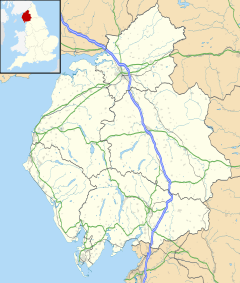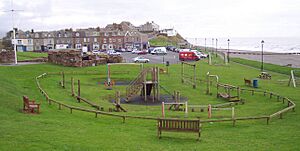Seascale facts for kids
Quick facts for kids Seascale |
|
|---|---|
 Seascale |
|
| Population | 1,709 (2021) |
| OS grid reference | NY0370300976 |
| Civil parish |
|
| District |
|
| Shire county | |
| Region | |
| Country | England |
| Sovereign state | United Kingdom |
| Post town | SEASCALE |
| Postcode district | CA20 |
| Dialling code | 019467 |
| Police | Cumbria |
| Fire | Cumbria |
| Ambulance | North West |
| EU Parliament | North West England |
| UK Parliament |
|
Seascale is a village located on the coast of the Irish Sea in Cumbria, England. It is a civil parish, which is a local government area. In 2021, about 1,709 people lived here.
Contents
History of Seascale
The name Seascale tells us that Norsemen (people from Norway) settled here a very long time ago, probably before the year 1000. The word skali in Norse means a wooden hut or shelter.
Many Norse people had settled in Ireland and the Isle of Man. When King Harold Fairhair wanted to get revenge on them, some fled across the sea to the Cumbrian coast around 885 AD. Seascale was one of the places they settled.
Other local names like Seascale How (meaning "hill near the shelter") and Whitriggs (meaning "the white ridge") also come from Norse words. Seascale was called this to show it was the "shelter by the sea."
The first time Seascale was written about was between 1154 and 1181. A person named Aldwin de Seascale was mentioned in a legal document. Another mention was in 1200, describing land near Leseschalis or Seascale.
For a long time, Seascale was mostly a group of farms. This changed when the Furness Railway arrived in 1850. This railway line connected Whitehaven to Barrow in Furness.
In 1879, Sir James Ramsden had a big idea to turn Seascale into a holiday resort. He planned a large hotel, walking paths along the sea, and many villas (fancy houses). However, only a few of these buildings were ever built.
The Scawfell Hotel, which was built around that time, was taken down in 1997. It used to advertise its nice beach and even had its own bathing machines for people to use. Seascale was also promoted as a great place to start trips into the western parts of the Lake District.
In 1881, the first church, called the "Iron Church" of St Cuthbert, was built. It blew down in 1884 but was rebuilt. Later, in 1890, a stone church was built because the community was growing. A Methodist Church was also built nearby in 1886.
Seascale grew much more when the Royal Ordnance Factories were built nearby in 1939. These factories made weapons. After World War II, a huge nuclear building project started at the former Sellafield factory.
Seascale then became a place where many workers from the Windscale and Calder Hall nuclear sites (now called Sellafield) lived. Because of this, in the 1950s, Seascale was known as "the brainiest town in Britain."
Location and Travel
Seascale is located just outside the beautiful Lake District National Park. The large Sellafield nuclear site is about 3 miles (5 km) away.
If you travel by road, Seascale is:
- About 21 miles (34 km) north of Millom.
- About 35 miles (57 km) north of Barrow in Furness.
- About 15 miles (24 km) south of Whitehaven.
The village is close to the A595 road. You can also reach Seascale by train, as it has its own Seascale railway station on the Cumbrian Coast Line.
How Seascale is Governed
Seascale is part of the Copeland UK Parliamentary constituency. This means that people in Seascale vote for a Member of parliament (MP) to represent them in the UK Parliament. The current MP is Trudy Harrison.
For local government, Seascale is in the Gosforth + Seascale ward of the Borough of Copeland. It is also in the Gosforth ward for Cumbria County Council.
The village also has its own local council, called the Seascale Parish Council. A Parish Council helps manage local services and represents the community. This local area stretches all the way to Scafell Pike, which is England's highest mountain.
Literary Connections
The famous Victorian writer George Gissing used Seascale as a setting for part of one of his novels, called The Odd Women.
Gissing first visited Seascale and the Lake District when he was young, around 1868 or 1869. Even though he only visited a few times, the area made a big impression on him. He used ideas and details from his visits in his writing for over 30 years.
See also
 In Spanish: Seascale para niños
In Spanish: Seascale para niños



